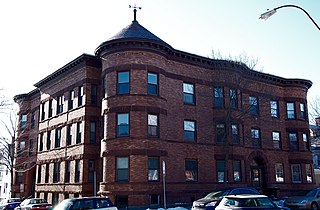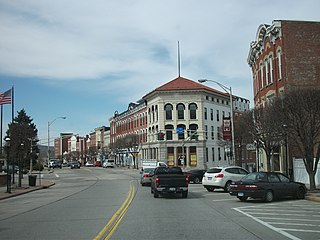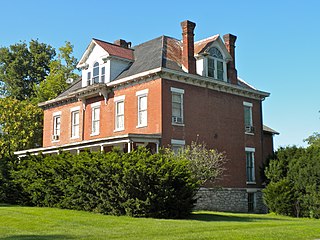
Ditmas Park is a historic district in the neighborhood of Flatbush in Brooklyn, New York City. The traditional boundaries of Ditmas Park, including Ditmas Park West, are Ocean Avenue and greater Flatbush to the east, Dorchester Road and the Prospect Park South neighborhood to the north, Coney Island Avenue and the Kensington neighborhood to the west, and Avenue H/Bay Ridge Branch and the Midwood neighborhood to the south. Ditmas Park is patrolled by the New York City Police Department's 70th Precinct, and is within Brooklyn Community District 14. The New York City Subway's B and Q trains serve Ditmas Park.

The Washington Avenue Historic District is located in Downtown West, St. Louis, Missouri along Washington Avenue, and bounded by Delmar Boulevard to the north, Locust Street to the south, 8th Street on the east, and 18th Street on the west. The buildings date from the late 19th century to the early 1920s. They exhibit a variety of popular architectural styles of those years, but most are revival styles or in the commercial style that would later come to be known as the Chicago School of architecture. Most are large multi-story buildings of brick and stone construction, built as warehouses for the St. Louis garment district. Many have terra cotta accents on their facades. After World War II, the decline in domestic garment production and the preference for single-story industrial space led to many of the buildings being vacant or underused due to functional obsolescence.
Mutual Musicians Foundation is a National Historic Landmark in Kansas City, Missouri.

The Paul Robeson Residence, also known by its street address of 555 Edgecombe Avenue, is a National Historic Landmarked apartment building, located at 555 Edgecombe Avenue at the corner of West 160th Street in the Washington Heights neighborhood of Manhattan, New York City. It was originally known as the "Roger Morris" when it was built in 1914-16 – after the retired British Army officer who built the nearby Morris-Jumel Mansion – and was designed by Schwartz & Gross, who specialized in apartment buildings. The building is architecturally relatively non-descript, with an exterior of brick and stone with nods to Beaux Arts architectural elements. It has thirteen floors and a penthouse. The main entrance is two stories in height, set in an arched opening with ironwork at the peak.

Highland Park is a historic park in Meridian, Mississippi, United States. Home to a museum honoring Jimmie Rodgers, a Meridian native, the site was listed on the National Register of Historic Places in 1979. The park is also home to the Highland Park Dentzel Carousel and Shelter Building, a National Historic Landmark manufactured around 1896 by Gustav Dentzel of Philadelphia, Pennsylvania. The historic carousel is the only two-row stationary Dentzel menagerie still in existence.

The First Universalist Church is a historic Universalist Church building at 125 Highland Avenue in Somerville, Massachusetts. The Romanesque church building was built between 1916 and 1923 to a design by Ralph Adams Cram, and is the only example of his work in Somerville. The building was listed on the National Register of Historic Places in 1989. It is currently owned by the Highland Masonic Building Association, and is the home of King Solomon's Lodge AF & AM, the builders of the Bunker Hill Monument.

The Highland is a historic multiunit residence at 66 Highland Avenue in Somerville, Massachusetts. The three story brick building was built in 1892 to a design by architect Samuel D. Kelley. It is one of the city's more elegant late 19th-century apartment houses, built during its rapid expansion in the late 19th century. The building listed on the National Register of Historic Places in 1989.

The Reading Public Library is located in Reading, Massachusetts. Previously known as the Highland School, the two-story brick-and-concrete Renaissance Revival building was designed by architect Horace G. Wadlin and built in 1896–97. The building served the town's public school needs until 1981. It is the town's most architecturally distinguished school building. It was listed on the National Register of Historic Places in 1984, the year it was converted for use as the library.

18th and Vine is a neighborhood of Kansas City, Missouri. It is internationally recognized as a historical point of origin of jazz music and a historic hub of African-American businesses. Along with Basin Street in New Orleans, Beale Street in Memphis, 52nd Street in New York City, and Central Avenue in Los Angeles, the 18th and Vine area fostered a new style of jazz. Kansas City jazz is a riff-based and blues-influenced sound developed in jam sessions in the district's crowded clubs. Many notable jazz musicians of the 1930s and 1940s lived or got started here, including Charlie Parker. Due to this legacy, U.S. Representative Emanuel Cleaver said 18th and Vine is America's third most recognized street after Broadway and Hollywood Boulevard.

Zion Lutheran Church is a historic Lutheran church located along Prospect Avenue near downtown Cleveland, Ohio, United States. Formed in the 1840s, the congregation built the present building shortly after 1900, along with an adjacent church school. Both buildings have been named historic sites. The school is no longer open.

The Downtown Ossining Historic District is located at the central crossroads of Ossining, New York, United States, and the village's traditional business district known as the Crescent. Among its many late 19th- and early 20th-century commercial buildings are many of the village's major landmarks—three bank buildings, four churches, its village hall, former post office and high school. It was recognized as a historic district in 1989 and listed on the National Register of Historic Places, as one of the few downtowns in Westchester County with its social and historical development intact.

The C. R. Joy House, also known as The Grande Anne Bed & Breakfast, was a historic building located in Keokuk, Iowa, United States. It was destroyed by fire in July 2018. It was individually listed on the National Register of Historic Places in 1997. In 2002 it was included as a contributing property in The Park Place-Grand Avenue Residential District.

The John N. and Mary L. (Rankin) Irwin House is a historic building located in Keokuk, Iowa, United States. It was individually listed on the National Register of Historic Places in 1999. In 2002 it was included as a contributing property in The Park Place-Grand Avenue Residential District.

The Highland Park Historic Business District at Euclid and Sixth Avenues is located in the north-central section of Des Moines, Iowa, United States. It is located on the border of the Oak Park and Highland Park neighborhoods. The commercial historic district has been listed on the National Register of Historic Places since 1998. The Highland Park neighborhood also includes the College Corner Commercial Historic Business District.

This is a list of the National Register of Historic Places listings in downtown Kansas City, Missouri.

This is a list of the National Register of Historic Places listings in Kansas City, Missouri outside downtown.
Rudolf Markgraf was an architect in the United States. Two buildings he designed are listed in the National Register of Historic Places and a third is a National Landmark.

The Ohio Baptist General Association Headquarters is a historic building in the Woodland Park neighborhood of Columbus, Ohio. It was listed on the Columbus Register of Historic Properties in 2019 and the National Register of Historic Places in 2020. The house was built for Jerimiah Foley from 1904 to 1905. It remained residential until 1954, when the Ohio Baptist General Association (OBGA) purchased it to act as its headquarters. The association dedicated the building in October 1957, and fully converted it to offices by 1958. The OBGA ceased operations in the building in 1996, and is partnering in a restoration effort to preserve its historic features. The building, listed on the 2018 Columbus Landmarks' "Most Endangered" register, is planned to gain residential units as well as return to acting as the organization's headquarters.

















